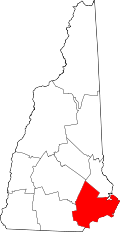Description and history
The Captain Jonathan Currier House stands at the three-way intersection of Hilldale Avenue with Currier Street and Lone Goose Road. It is set facing south toward the intersection and close to the road. It is a 2+1⁄2-story wood-frame structure, with a side-gable roof, central brick chimney, and clapboarded exterior. Its main facade is five bays wide, with a central entrance flanked by simple pilasters and topped by a transom window and cornice. A single-story ell extends at an angle from the rear of the house, parallel to Hillside Avenue. [2]
The house, a typical vernacular Georgian style construnction, was built c. 1742 by Jonathan Currier, whose family was among the early settlers of the western part of South Hampton, and for whom the area is named Currierville. It is the oldest house standing in the area, a significant agricultural settlement in the 18th and 19th centuries. Because of its proximity to nearby Newton, the area's residents, including Currier and others in his family, twice petitioned the state (without success) to become part of Newton. [2]
This page is based on this
Wikipedia article Text is available under the
CC BY-SA 4.0 license; additional terms may apply.
Images, videos and audio are available under their respective licenses.



